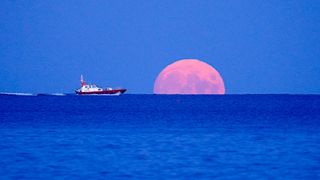Harvest Moon 2021 offers stunning views to skywatchers around the globe (photos)

Stargazers across the globe celebrated this year's magical Harvest Moon last night (Sept. 20), which marked the end of the summer season just two days before the autumnal equinox.
Last night, skywatchers in America got a clear view of the Harvest Moon, while those in Europe, Asia, Australia and most of Africa could also observe the celestial spectacle, though the moon will only turn perfectly full for them tonight (Sept. 21).
Related: How to photograph the moon using a camera: techniques, kit, and settings







Orion GoScope II 70 Telescope Moon Kit: $89.99 at Amazon
If you know a youngster who can't get enough of the moon, then they'll be delighted with views through the Orion GoScope II. Revealing craters and seas up close, this little telescope comes with a carry case and moon map.
In the U.K., brave swimmers took to the sea in Falmouth, Cornwall, in the south of England, to take a dip in the cold Atlantic waters under the moon's bright light.
The Harvest Moon, also known as the Full Corn Moon or the Full Barley Moon, coincides with the harvest season in Europe and Northern America. Historically, farmers have relied on its bright light to keep working long into the night.
Today, the Harvest Moon continues to provide an enjoyable spectacle and photo opportunity for many, as it rises over some of the world's most famous landmarks.
Marking the arrival of the autumn in the Northern Hemisphere, the Harvest Moon coincides with a rapid shortening of the day. On the morning of the autumnal equinox on Sept. 22, the sun rises at 6:56 a.m. By the time of the next full moon on Oct. 20, the sunrise slips to 7:23 a.m. local time, according to NASA.
Get the Space.com Newsletter
Breaking space news, the latest updates on rocket launches, skywatching events and more!
The Harvest Moon, which on the U.S. East Coast reached the perfectly full phase at 7:55 p.m. EDT on Monday (Sept. 20), will appear full until Wednesday (Sept.22) morning.
The Harvest Moon was accompanied by Venus and Jupiter as the two most prominent objects currently in the early evening sky. As the moon rose in the constellation of Pisces, Venus was visible about 7 degrees above the horizon in the west-southwest. Jupiter then appeared 24 degrees above the horizon in the southeast. Saturn, the faintest of the visible planets in the sky, was visible 27 degrees above the horizon in the south-southeast, according to this NASA guide.
Follow Tereza Pultarova on Twitter @TerezaPultarova. Follow us on Twitter @Spacedotcom and on Facebook.
Join our Space Forums to keep talking space on the latest missions, night sky and more! And if you have a news tip, correction or comment, let us know at: community@space.com.

Tereza is a London-based science and technology journalist, aspiring fiction writer and amateur gymnast. Originally from Prague, the Czech Republic, she spent the first seven years of her career working as a reporter, script-writer and presenter for various TV programmes of the Czech Public Service Television. She later took a career break to pursue further education and added a Master's in Science from the International Space University, France, to her Bachelor's in Journalism and Master's in Cultural Anthropology from Prague's Charles University. She worked as a reporter at the Engineering and Technology magazine, freelanced for a range of publications including Live Science, Space.com, Professional Engineering, Via Satellite and Space News and served as a maternity cover science editor at the European Space Agency.
